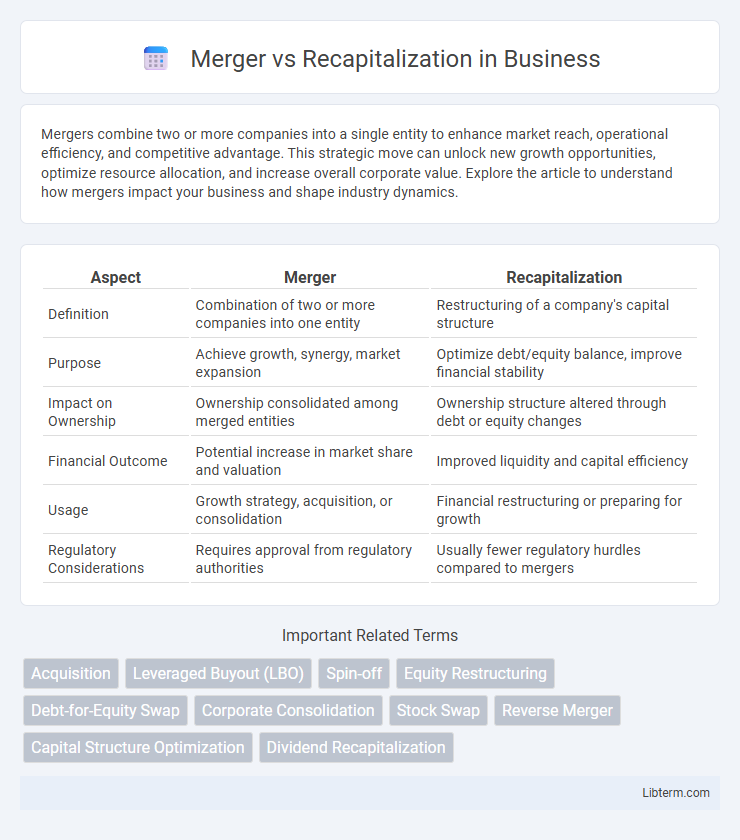Mergers combine two or more companies into a single entity to enhance market reach, operational efficiency, and competitive advantage. This strategic move can unlock new growth opportunities, optimize resource allocation, and increase overall corporate value. Explore the article to understand how mergers impact your business and shape industry dynamics.
Table of Comparison
| Aspect | Merger | Recapitalization |
|---|---|---|
| Definition | Combination of two or more companies into one entity | Restructuring of a company's capital structure |
| Purpose | Achieve growth, synergy, market expansion | Optimize debt/equity balance, improve financial stability |
| Impact on Ownership | Ownership consolidated among merged entities | Ownership structure altered through debt or equity changes |
| Financial Outcome | Potential increase in market share and valuation | Improved liquidity and capital efficiency |
| Usage | Growth strategy, acquisition, or consolidation | Financial restructuring or preparing for growth |
| Regulatory Considerations | Requires approval from regulatory authorities | Usually fewer regulatory hurdles compared to mergers |
Introduction to Mergers and Recapitalizations
Mergers involve the combination of two or more companies into a single entity to achieve synergies, market expansion, or competitive advantage, often resulting in shared assets, liabilities, and operational control. Recapitalizations restructure a company's capital framework by altering the mix of debt and equity to improve financial stability, support growth, or defend against takeovers without changing the company's operations or management. Both strategies serve strategic corporate finance purposes but differ fundamentally in intent, structure, and impact on ownership and control.
Defining Mergers: Key Concepts
Mergers involve the consolidation of two or more companies into a single entity to achieve synergies, expand market share, or diversify offerings. Key concepts include the merging of assets, liabilities, and equity, with one company often surviving and absorbing the others, creating operational efficiencies and enhanced competitive advantage. Understanding the types of mergers--such as horizontal, vertical, and conglomerate--helps in assessing strategic fit and regulatory considerations.
Understanding Recapitalization: An Overview
Recapitalization restructures a company's equity and debt mixture to stabilize its capital base, improve financial health, and optimize shareholder value without changing the company's ownership structure. Unlike mergers, which combine two separate entities into one, recapitalization often involves issuing new debt, buying back shares, or converting debt to equity to reposition the company strategically. This financial maneuver enables firms to manage risk, reduce costs, and respond to market or internal financial challenges effectively.
Strategic Objectives: Why Companies Merge
Companies merge to achieve strategic objectives such as market expansion, increased operational efficiency, and enhanced competitive advantage. Mergers enable the consolidation of resources, technology, and talent to drive growth and innovation while achieving economies of scale. This integration often aims to diversify product offerings and enter new markets faster than organic growth allows.
Recapitalization Goals: Motivations and Benefits
Recapitalization goals primarily focus on improving a company's capital structure to enhance financial stability and flexibility. Key motivations include reducing debt burdens, optimizing equity-to-debt ratios, and raising funds for growth or strategic initiatives. Benefits of recapitalization consist of lowering borrowing costs, supporting long-term investment plans, and increasing shareholder value by stabilizing or boosting stock prices.
Key Differences Between Mergers and Recapitalizations
Mergers involve the combination of two or more companies into a single entity, resulting in consolidated management, operations, and ownership, while recapitalizations restructure a company's debt and equity mix to improve financial stability without changing its core business structure. In mergers, shareholder ownership is exchanged for shares in the new entity, whereas recapitalizations often involve issuing new debt or equity to adjust the capital structure without altering ownership significantly. The fundamental difference lies in the outcome: mergers create a new or expanded company through integration, whereas recapitalizations modify existing financial arrangements to optimize leverage or liquidity.
Financial Implications: Comparing Both Strategies
Merger typically involves combining assets and liabilities of companies, often leading to significant changes in capital structure and shareholder equity, whereas recapitalization focuses on restructuring a company's debt and equity mix to improve financial stability without altering ownership significantly. The financial implications of a merger include potential synergies, cost savings, and increased market value, contrasted with recapitalization's effect on reducing interest expenses, improving debt ratios, and enhancing creditworthiness. Both strategies impact cash flow, tax obligations, and investor perceptions, but mergers generally carry higher integration costs and financial complexity compared to the targeted balance sheet adjustments in recapitalization.
Risks and Challenges in Mergers vs Recapitalizations
Mergers pose significant risks such as cultural integration issues, regulatory approval delays, and potential loss of key personnel that can disrupt business continuity. Recapitalizations carry financial restructuring challenges, including increased debt burdens and dilution of existing shareholders' equity. Both strategies demand thorough due diligence to mitigate operational, financial, and market risks inherent in combining or restructuring company assets.
Case Studies: Real-world Examples
Case studies such as the Disney-Pixar merger highlight the strategic benefits of mergers in achieving synergies and market expansion, while recapitalization examples like Apple's 2013 debt issuance demonstrate how companies optimize capital structure to support innovation and shareholder value. The AOL-Time Warner merger illustrates risks including cultural clashes and integration challenges, whereas Tesla's recapitalization efforts through equity offerings and convertible debt emphasize flexibility in funding growth. These real-world examples underscore how mergers aim for consolidation and scale, whereas recapitalizations focus on financial restructuring to enhance operational efficiency.
Conclusion: Choosing the Right Path for Corporate Growth
Selecting between merger and recapitalization depends on a company's strategic goals, financial structure, and market conditions. Mergers drive growth through synergy and market expansion, while recapitalization optimizes capital structure to improve financial stability or fund initiatives. Analyzing long-term objectives alongside immediate financial needs ensures the optimal corporate growth strategy.
Merger Infographic

 libterm.com
libterm.com